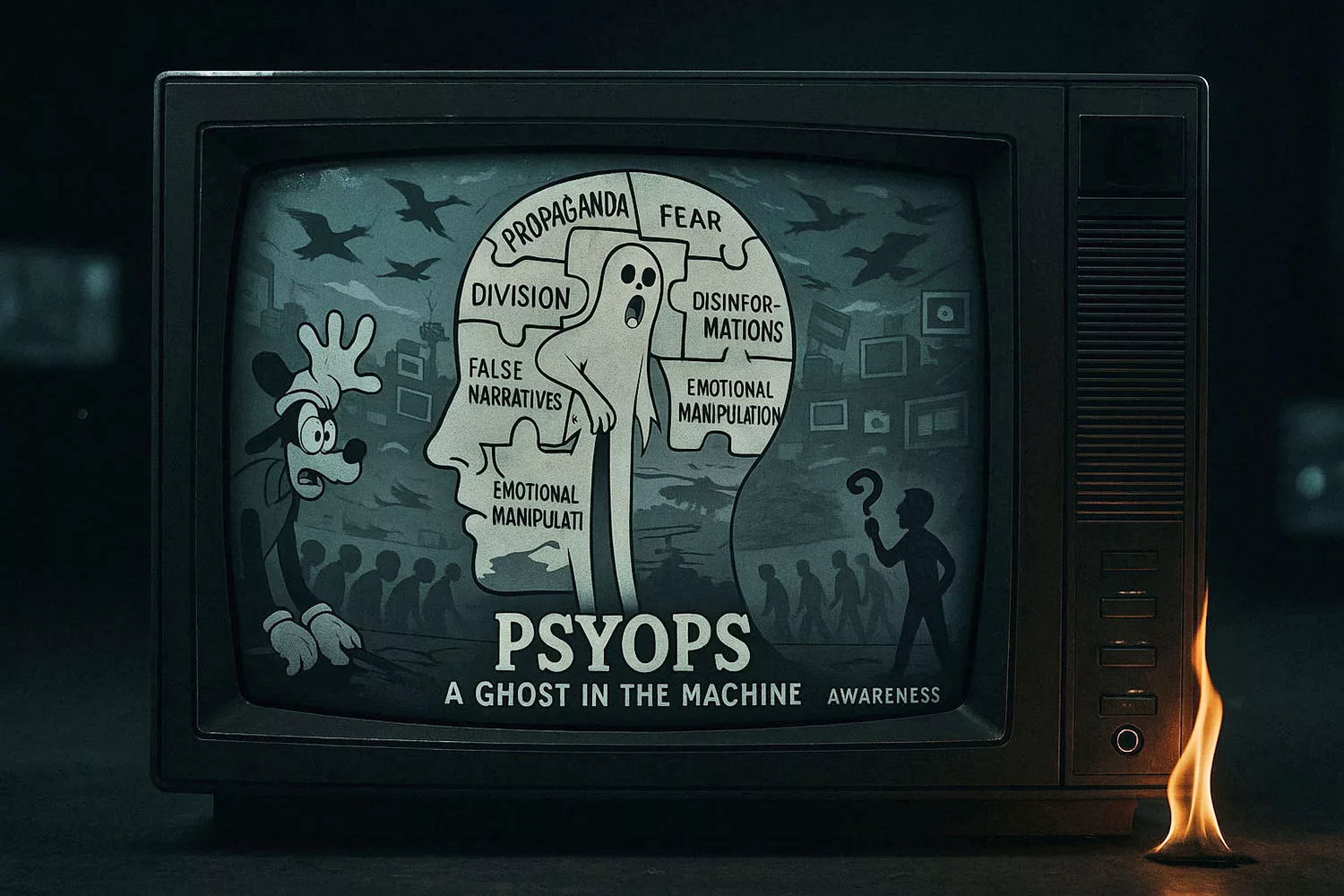
by Jesse Smith
May 27, 2024
from TruthUnmuted Website
A centuries-old plan to control humanity on a micro-level is being enforced through the construction of a new bio-digital prison system…
Relegated to mere conspiracy theory by legacy media and vehemently denied by accused conspirators, the plan continues unabated with only pockets of resistance – nowhere near enough to bring the house of cards down.
The plan has been identified by many throughout the decades.
It is both,
- simple and complex
- subtle yet overt
- ancient yet contemporary
- alluring yet appalling…
Under the guise of safety, convenience, and inclusion, humanity is being primed to accept complete and total surveillance as a condition of simple existence in a “brave new world.”
That’s the plan in a nutshell.
What follows are the gory details…
The Era of Cognitive Warfare
To accelerate the paradigm shift toward total surveillance, cognitive warfare (CW) – a significant upgrade over mere psyops of the past – has been declared on the global population.
The purpose of this war is to modify human thought, belief, behavior, and identity.
According to a 2021 NATO report, cognitive warfare is defined as (emphasis added throughout):
“a combined arms approach that integrates the non-kinetic warfare capabilities of cyber, information, psychological and social engineering in order to win without physical fighting. It is a new type of warfare defined as the
weaponization of public opinionby external entities. This is carried out for the purpose of influencing and/or destabilizing a nation.”
A separate NATO report from 2022 adds that cognitive warfare is:
“…the most advanced form of
human mental manipulation, to date, permitting influence over
individual or collective behavior, with the goal of obtaining a tactical or strategic advantage. …the
human brain becomes the battlefield. The pursued objective is to influence not only
what the targets think, but also
the way they thinkand, ultimately,
the way they act.”
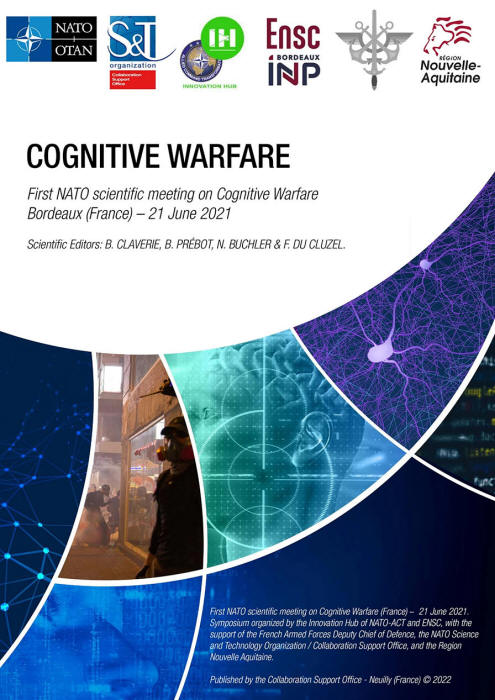
The U.S. Naval Institute has also recognized the need for a cognitive warfare strategy, stating:
“…An individual’s cognition is now a target.
Advances in cognitive psychology and information communication technology (ICT) enable actors to
target individuals’ situational comprehension and will with precision. In light of these changes, cognitive warfare (CW) has emerged as a new war-fighting concept…
Cognitive warfare operations will take on many forms and unfold along varying timelines.
Some may focus on reinforcing groups’ or individuals’ existing ideals, while others may seek
to disrupt cohesion or accepted beliefs.
The U.S. approach to CW, however, must uphold U.S. values.”
Adding that technologies like machine learning and brain-computer interfaces (BCI) boost the efficiency of cognitive warfare, the Geneva Center for Security Policy (GCSP), a frequent NATO collaborator, further opined that:
“Current and future developments in artificial intelligence (AI), cognitive sciences, neurotechnologies, and other related fields will further
increase the risks of mass manipulationand lead to the possibility of
the militarization of the mindas the battlefield of the future…
The resulting environment is one of “permanent latent struggles” rather than a clearly delineated state of peace and war. This state has been referred to as “new generational warfare”, “unpeace” or conflict in the “noosphere”.
To summarize what cognitive warfare entails, I offer the following definition:
the weaponization of public opinion, manipulation and militarization of the human mind, and engineering of individual and collective behavior resulting in permanent new generation warfare, “unpeace,” and conflict in the “noosphere.”
Wait, what on earth is the noosphere?
Unfamiliar to most, the noosphere is a concept advanced largely by Pierre Teilhard de Chardin, a 20th century Jesuit priest who fused together elements of biblical doctrine, evolution, and mysticism.
Teilhard conceived the noosphere as a realm where human minds interacted through increasingly complex social networks.
He theorized that the evolving noosphere would eventually reach an “Omega Point,” where the total convergence of collective human consciousness would unify with the “Cosmic Christ.”
These teachings were deemed heretical by the Catholic church and Teilhard was publicly denounced.
However, his posthumous writings have influenced scores of scientists, futurists, environmentalists, globalists, occultists, new agers, and ironically many Catholics.
One of Teilhard’s most revealing statements undergirding his philosophy is found in his book Christianity and Evolution, where he wrote:
“What I am proposing to do is to narrow that gap between pantheism and Christianity by bringing out what one might call the Christian soul of Pantheism or the pantheist aspect of Christianity.”
(p. 56)
It is Teilhard’s pantheistic views that endear him to the scientific and Big Tech communities. They took up the mantle of advancing the noosphere through technologies like the Internet and social media, hoping humanity would realize Teilhard’s vision.
It is this writer’s contention that the supreme goal of CW and the digital revolution is to turn Teilhard’s Omega Point from theory into reality.
Creating a Collective Human Consciousness
“The noosphere’s evolution involved the scale of human groups as well as the nature of the information networks that connected humans and technologies of all sorts…
With each new information technology, the shared knowledge contained in the collective consciousness of the Noosphere grew, and the rate of its growth accelerated.” [
NATO’s 2021 report indicated that neuroscientific warfare techniques can be used to destabilize,
“a political leader, a military commander, an entire staff,
a population, or an Alliance…”
As a result, governments and militaries from many nations are working feverishly to combat the threat mind wars pose to citizens and nations.
Their alleged goals are to maintain trust in democratic values and processes while simultaneously implementing greater controls on the flow of information. Paradoxically, they are attempting to maintain (the illusion of) freedom, while authorizing new forms of digitized censorship “for the greater good.”
What is really taking place is a game of bait and switch where citizens are told that due to the proliferation of misinformation, disinformation, hate speech, identity theft, deep fakes, and cyber-attacks, greater control is needed to police the digital public square.
Add in the so-called threat of climate change, financial collapse, war, the energy crisis, future pandemics, and you have what the United Nations (UN) and World Economic Forum (WEF) deem a “polycrisis.”
Tools such as artificial intelligence (AI), Central Bank Digital Currency (CBDC), biometric surveillance, and digital ID, have emerged as the “solutions” to these problems.
Whether the evolving bio-digital surveillance paradigm is called the,
- Fourth Industrial Revolution (4IR)
- Great Reset
- Agenda 2030
- Humanity 2.0,
…what’s common is the belief that bigger and better tech can transform society “for good” and combat issues of mistrust, corruption, crime, and planetary destruction.
However, realizing this utopian vision requires greater levels of transparency, control, conformity, and collective thought.
To successfully manipulate the public into either full acceptance or forced submission of this paradigm, the twin brothers of tyranny – surveillance and censorship – have been invoked.
Klaus Schwab, former Executive Chairman of the WEF, spoke about this new world where privacy is “severely restricted” in a 2013 interview, mentioning:
Everything is transparent, whether we like it or not. This is unstoppable. If we behave acceptably, and have nothing to hide, it won’t be a problem.
The only question is, who determines what is acceptable.”
In a 2016 interview with Radio Television Suisse, Schwab elaborated further on transparency, stating,
“In the new world, you have to accept total transparency. It will become part of your personality… Everything will be transparent.
If you have nothing to hide you have no reason to be afraid.”
| |
It’s easy to highlight statements from Schwab given his notoriety as a globalist boogeyman.
Perhaps this is one of the reasons for his recent withdrawal as the WEF’s front man? Regardless, Schwab is just one of many who champion surveillance technologies to complete the transition to the new world order of total transparency.
In iHuman, a documentary on AI, data scientist and Stanford Professor Michal Kosinski echoes Schwab’s convictions regarding the current state of privacy, declaring:
Of course people should have rights to their privacy when it comes to sexual orientation or political views.
But I’m also afraid that in our current technological environment this is essentially impossible. People should realize there is no going back, there’s no running away from the algorithms.
The sooner we accept the inevitable and inconvenient truth that
privacy is gone, the sooner we can start actually thinking about how to make sure our societies are ready for the
post-privacy age.”
Once an imagined dystopia but now quickly becoming reality, omnipresent bio-digital surveillance creates an inescapable societal panopticon.
The “new world” Schwab refers to is being steered by the technocratic elite running all governments, corporations, NGOs, universities, medicine, and media.
Publicly, the surveillance society is sold as a way to bring order to a chaotic world splintered politically, racially, economically, socially, and ideologically.
Privately, it is recognized as an iterative way to forge collective human consciousness as we march toward the transhumanist vision of “Singularity,” or as Teilhard would claim, the “Omega Point.”
As this push accelerates, companies like Palantir, Amazon, and Clearview AI along with Big Brother government agencies like NSA, DHS, CIA, and the FBI continue to amass enormous amounts of data containing essentially all activity occurring in the digital space.
Smart technology and the Internet of Things (IoT) bring the all-seeing eye of technocratic overlords into the private spaces of a growing number of residences and businesses.
Backdoors in software and cyber-crime offer access to huge amounts of data believed to be private and protected, but often sold to the highest bidder.
Microsoft is upping the ante on personal surveillance.
With its new AI-assisted
Windows Recallfeature that takes screenshots of everything you do on your computer, the PC transforms into an open book recalling your entire life.
Could a backdoor allow for the AI algorithm to transmit all private data back to Microsoft and its spook agency partners in real time?
| |
As I’ve written previously, Internet of Bodies devices exist to monitor and transmit all personal data to the Internet. This industry is now broadening to include an Internet of Brains, where,
“human brains connect to the Internet to facilitate direct brain-to-brain communication and enable access to online data networks.”
The military-intelligence complex has been conducting experiments on the human brain for a long time.
The CIA’s MK-Ultra and the White House’s Brain Initiative are just two examples revealing the government’s longing to hack the brain and create a hivemind society where thoughts and actions can be directly controlled through technology and/or mind-altering substances.
The company behind both reports connecting bodies and brains to the Internet is the RAND Corporation. RAND’s first president, H. Rowan Gaither, declared his goal to be,
“a society where technocrats ruled using objective analysis.”
Author Alex Abella, who wrote the definitive book on RAND, expounded on their technocratic goals, saying:
RAND’s ultimate goal was to have technocrats running every aspect of society in pursuit of a one world government that would be administered under “the rule of reason,” a ruthless world where efficiency was king andmen were little more than machines, which is why RAND studied the social sciences because they were at a loss to work out how to deal with people and how human beings did not always act in their own predictable self-interests.”
RAND has certainly done its part in forging collective consciousness and building the technocratic new world order.
Its website openly boasts that “satellites, systems analysis, computing, the Internet – almost all the defining features of the Information Age were shaped in part at RAND.”
AI, Biometrics and Digital ID – Tools of Freedom or Tyranny?
“I’ve often said that digital inclusion is extremely important.
I think the 21st century’s infrastructure is mobility, broader than cloud. I don’t think it should matter where you are born, where you come from or who you are.
You should be part of our society, and to be part of our society, you actually need to be digitally included.”
Chief Executive Officer of Verizon
In the papers quoted previously on cognitive warfare, malicious manipulation of digital technology is viewed as a heinous crime that must be stopped at all costs.
However, it can be argued that cognitive warfare has been perpetuated against the entire world population through the process of digitization itself.
The Digital Revolution (aka the Information Age or Third Industrial Revolution) transitioned the world from analog and mechanical devices to the digital technology of today. This Third Industrial Revolution is now giving way to the 4IR, where the ultimate goal is to merge man with machines.
This futurist archetype denigrates humanity to mere bits of data – ripe for control and manipulation by the data owners.
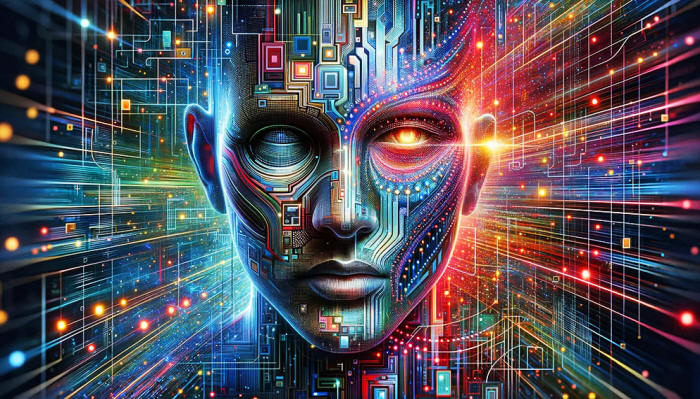
Image: Adobe Stock
Humans once widely considered God’s crowning achievement – reflecting the very image of the Creator of all things – are now being transitioned through self-directed evolution to forge a new identity by becoming one with technology.
Venture into any public space and it’s likely you’ll see most people transfixed by their smartphones, oblivious to real humans nearby. But this revolution, largely mainstreamed by Steve Jobs and Apple, was just the beginning.
The complete transition requires the unholy trinity of AI, biometrics, and digital ID, to serve as a temporary global brain until humanity reaches the imagined transcendence where godhood itself is achieved.
AI is simultaneously being heralded as the greatest human achievement ever and excoriated as the greatest threat to human survival.
Filmmaker Tonje Hessen Schei unveiled both perspectives in her documentary iHuman.
Two of the most eye-opening statements occur within the film’s first ten minutes.
We are made of data.
Every one of us is made of data – in terms of how we behave, how we talk, how we love, what we do every day.
So, computer scientists are developing deep learning algorithms that can learn to identify, classify, and predict patterns within massive amounts of data.
We are facing a form of precision surveillance, you could call it algorithmic surveillance, and it means that you cannot go unrecognized.
You are always under the watch of algorithms.Eleonore Pauwels,
United Nations University
Almost all the AI development on the planet today is done by a handful of big technology companies or by a few large governments.
If we look at what AI is mostly being develop for, I would say it’s killing, spying, and brainwashing…
We have military AI, we have a whole surveillance apparatus being built using AI by major governments, and we have an advertising industry which is oriented toward recognizing what ads to try to sell to someone.Ben Goertzel,
Chief Computer Scientist, Hanson Robotics
AI has come a long way since the film’s release in 2020, and Big Tech leaders and investors such as Sam Altman, Elon Musk, and Peter Diamandis offer a more positive outlook.
Some of the good AI is being used for includes detecting deadly weapons, diagnosing life-threatening health problems, protecting biodiversity, and improving access to nutrients and water.
Another “good” outcome according to Musk is that “probably none of us will have a job” and instead will have to rely on “universal high income,” a fantasy unlikely to come true.
To top it off, he predicts humans will be relegated to “giving AI meaning” while man’s meaning fades away.
When asked how humans will navigate our identity as AI continues to expand, Ray Kurzweil, futurist and Google director of engineering, said:
“It’s going to be merged with us. We already carry around a lot of digital intelligence today and that’s actually how this will be manifest, merging it with ourselves.”
During this same event, Peter Diamandis, XPrize Foundation and Singularity University founder, discussed meshing our minds together into a “hive consciousness,” a concept he refers to as “Meta-Intelligence.”
Can both outlooks regarding the future of AI be true?
One describes killing, brainwashing, and oppressive surveillance while the other forecasts planetary and individual problem solving and a glorious merger of man and machine.
Are the positives being oversold to suspend doubts and fears regarding potential negative outcomes?
Perhaps an examination of digital ID and biometrics can provide some clarity on which view is most accurate.
One ID to Rule Them All
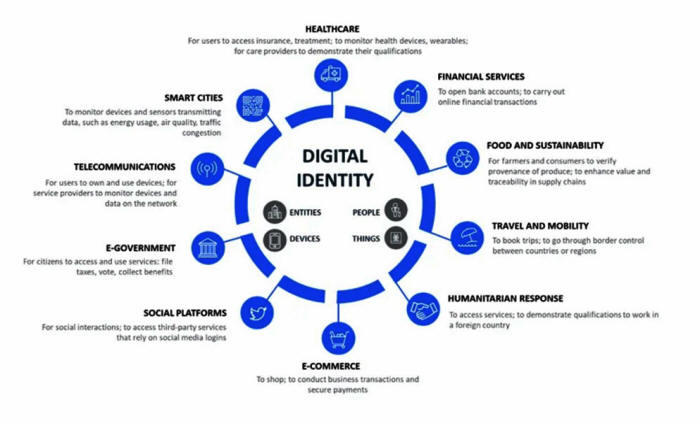
Source:
The United Nations Agenda 2030 Sustainable Development Goals (SDGs) play a prominent role in advancing global digital transformation. Each of the 17 SDGs functions as a roadmap to permanently restructuring a portion of society.
All 193 UN member nations are in lockstep with the plan.
SDG 16 – Peace, Justice, and Strong Institutions says that,
“by 2030, [all countries must] provide legal identity for all, including birth registration” delivering the justification for digital IDs. SDG 1 –
No Poverty, advocates for “digital IDs linked with bank or mobile money accounts” to “improve the delivery of social protection coverage and serve to better reach eligible beneficiaries.”
According to the United Nations Development Programme (UNDP), further justification for digital legal IDs include:
- Identifying the displaced – tracking population movements, facilitating swift access to essential information for each human being.
- Using digital ID for registration – enabling the capture of disaggregated data by age, gender, disability, and income, offering insights into the diverse impacts of disasters on different groups.
- Disaster preparedness and emergency management – storing valuable personal information, including residence and medical conditions and aid in identifying vulnerable populations and critical infrastructure.
- Energy system sustainability and resilience – leveraging digital legal ID data to track energy consumption, inspire behavior change, and enhance sustainability measures can mitigate climate-related disasters.
- Empowering communities – revolutionizing community participation in the energy sector by providing secure access to energy resources and enabling energy trading within community microgrids.
On the surface, these reasons for digital ID seem legitimate and even noble.
The UN and its government and NGO partners always sell the need for digital ID under the guise of:
- fostering economic and social inclusion
- tracking immigrants, migrants, and refugees
- protecting against identity theft and financial fraud
- simplifying access to government services
- lessening exposure of personal information through cyber attacks
- enhancing convenience
- promoting information integrity
- mitigating the climate and energy crises
- reducing human error in identifying individuals
- slowing human trafficking
It’s hard to argue these are not altruistic goals. Nonetheless, digital IDs can also be used to:
- employ 24/7 surveillance and data collection
- restrict travel and access to goods and services
- destroy privacy and online anonymity
- restrict access to social media and Internet services
- track compliance with medical dictates
- control access to banking, public services, public spaces, entertainment venues, medical facilities, workplaces, schools, etc.
- create a social credit system that ranks individuals based on government compliance
- limit access to vital needs such as water, food, and energy
- compromise a person’s identity through security breaches
According to Comparitech, 50 countries already have fully digitized identification schemes, overlooking the dangers highlighted. The rest of the world is also hastily moving forward to create digital public infrastructure (DPI), where digital ID takes center stage.
A few recent headlines attest to this urgency.
- UN, Gates Foundation ’50-in-5′ campaign aims to rollout digital public infrastructure in 50 countries by 2028
- Europe’s digital ID regulation takes effect, paving way for mobile wallet
- Australia moves towards ‘economy-wide’ digital ID system as legislation passed
- Africa’s digital ID journey on track: countries share experience at ID4Africa AGM
- Italy prepares for the digital transformation with IT wallet launch in 2025
- Belgium launches national digital identity wallet
- Major Australian bank launches digital ID app ahead of national program
- Sri Lanka’s digital identity transformation seeks balance of speed and assurance
- FAA reauthorization bill approves use of digital IDs at airports
- 42% of companies ready to adopt digital ID, new Regula study shows
- Visa goes all in with generative AI and digital ID
- New X policy forces earners to verify their government ID with Israeli verification company
Despite all the glowing promises from the UN, digital IDs threaten to give governments the ability to control a person’s life down to minute details.
Brett Solomon, a digital human rights advocate and executive director of Access Now, agrees, mentioning that digital ID,
“poses one of the gravest risks to human rights of any technology…”
He further adds that,
“we are rushing headlong into a future where new technologies will converge to make the risk much more severe.”
Papers No Longer Needed – Just Your Face
“If corporations and governments start harvesting our biometric data en masse, they can get to know us far better than we know ourselves, and they can then not just predict our feelings but also manipulate our feelings and sell us anything they want – be it a product or a politician.
Biometric monitoring would make Cambridge Analytica’s data hacking tactics look like something from the Stone Age.”
Yuval Noah Harari
One of the converging technologies increasing the threat from digital IDs is biometric identification.
This rapidly growing field includes identifying humans through facial recognition, iris and retina scans, fingerprints, voice recognition, gestures, bodily implants, DNA matching, and gait (how humans walk and move).
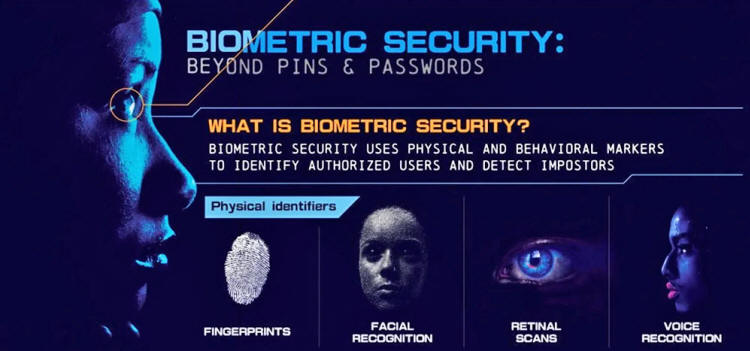
Source:
Even more frightening is the proposed use to detect:
Facial recognition stands out as the most pervasive and perhaps most problematic biometric tactic.
It is being used by law enforcement and border control, in medical facilities, retail stores, stadiums, airports, and government buildings. It’s utilized by banks and financial services, healthcare, and governments to verify identity.
It is also a fundamental building block for the creation of smart cities.
Each use case may provide benefits such as convenience and security but also poses risks that could exacerbate tyrannical control of the population.
With technologies poised to detect emotion and mental state, a Minority Report-style precrime detection regime could be installed.
But what happens to those who have been misidentified?
What about those penalized for minor infractions like jaywalking or criticizing the government as exemplified in China’s
Digital ID and biometric technologies have been introduced as a technocratic panacea offering greater inclusivity, convenience, and safety.
In reality, they reduce human identity to a sequence of cloud-stored data while enabling total surveillance of travel, economic activity, and health status with the potential to obliterate privacy and anonymity.
I’m sure they exist, but I’ve never met anyone desiring a digital ID, especially after the autocratic fiasco of vaccine passports during the COVID era.
According to a report by Iain Davis and Whitney Webb, this resistance is not imaginary, as they indicated,
“the rollout of CBDCs and the prerequisite digital ID has so far been a disaster for the regime.
Regardless of the culture, people in India,
Chinaand
elsewherehave shown a distinct lack of enthusiasm for embracing their planned digital future. In fact, they are actively resisting in
Australia is one country that faced staunch opposition to its digital ID plans.
Though its digital ID system legislation was recently passed by Parliament, it did not go without resistance. In fact, concessions were made to those expressing concerns about privacy, biometric testing, and mandatory usage within the legislation.
A recent Sky News video describes the extent of the resistance, echoing many of the concerns we have already presented.
The cognitive warfare-op has been deliberately engineered to make people think there is a bottom-up demand for digital surveillance tools.
Conversely, the demand is coming solely from the top through the,
- United Nations
- World Economic Forum
- World Bank
- G20
- World Trade Organization
- Rockefeller Foundation
- Bill & Melinda Gates Foundation
- Central Banks
- Council on Foreign Relations
- Better Identity Coalition
- Apple
- Visa and Mastercard
- ID2020
- Digital Impact Alliance
- Sovrin Foundation
- Thales
- Idemia
- governments worldwide,
…and a host of private companies too numerous to mention.
Digital ID can conceivably allow surveillance of everything one does and says online. With the overemphasis on mis- and disinformation, digital IDs can strengthen Big Tech and government’s ability to control speech.
By censoring, deplatforming, and restricting access, ideas and speech deemed “hateful” or contrary to accepted narratives can be suppressed, erased, or prevented from ever appearing.
One of the ways to dismiss concerns is by reassuring citizens that digital IDs will not become mandatory and that other forms of ID will still be accepted.
However, these assurances seem unlikely to last given the billions of dollars being spent on digital ID efforts from governments and corporations worldwide.
The switcheroo will probably occur sooner or later.
A Freer, Decentralized or More Tightly Controlled World?
“Government is the biggest threat to digital data anywhere around the world…
What is national security? All a government needs to do to violate a person’s right to privacy is write a letter and cite national security.”
Solomon Okedara,
Digital Rights Lawyers Initiative
We have been constantly told that the digital genie unleashed can’t be put back in the bottle.
Scientists, tech wizards, and bureaucrats are seizing opportunities to craft the future and stake their claim to the billions of dollars up for grabs in research, development, and deployment.
There’s no doubt that some good may come from their efforts.
As history has shown, whether technology is used for good or evil depends on the intent of those who possess and control it. The tools of digital transformation may benefit society, alleviating some of the frustrating, time-wasting processes we regularly engage in.
But the potential for social, financial, and even mental control must not be disregarded.
Freedom, liberty, and justice depend on eternal vigilance.
Is it mere coincidence that bio-digital surveillance tech such as AI, digital ID, biometrics, CBDC, IoT, Smart Meters, and 5G all working together can achieve the societal vision described in
The Technocracy Study Courseof 1945?
Is it also by chance that many of the UN SDGs mirror many elements outlined in this publication?
Technocracy expert Patrick Wood doesn’t believe so, noting that:
…technocrats demand that every single person in society be forced to participate in their system. Outliers were not to be allowed then, nor are they to be allowed today.
Want proof? Look for the motto “Ensuring that no one is left behind” throughout the United Nations’ literature on sustainable development.
Another word for “ensure” is “guarantee.” Globalists’ guarantees take the form of “mandates.”Patrick Wood
(p. 68), Kindle Edition
Going further, Wood adds that:
According to
The Technocracy Study Course, the anticipated and promised “end products” would be:
- A high physical standard of living
- A high standard of public health
- A minimum of unnecessary labor
- A minimum of wastage of non-replaceable resources
- An educational system to train the entire younger generation indiscriminately as regards all considerations other than inherent ability – a Continental system of human conditioning. (Ed. Note: human conditioning is not education but rather propaganda-style indoctrination.)
Not surprisingly, these outcomes overlap perfectly with
the United NationsSustainable Development Goals(SDGs) adopted at the 2030 Agenda conference in September 2015:
- Goal #1 – No poverty
- Goal #3 – Good health and well-being (the banner on Goal #3 states: “Vaccinate your family to protect them and improve public health”)
- Goal #8 – Decent work and economic growth
- Goal #12 – Responsible Consumption and Production
- Goal #4 – Quality education
Wood also exposes the supreme value of data to technocratic systems, disclosing that:
To technocrats, there is no such thing as too much surveillance. When they attain one level of monitoring, their next step is to increase the level of magnification and collect even more data.
Their addiction to data is unquenchable and unstoppable!”.
(p. 126)
The bio-digital surveillance system of today certainly fits everything Wood highlights.
It is akin to a modern-day techno Tower of Babel. Whether or not it’s desired, mankind is being pushed toward life in a digital world bereft of privacy, individuality, and agency.
The apostles of AI, transhumanism, and bio-digital surveillance are coercing the populace into their collective consciousness paradigm.
Using cognitive warfare techniques to implant their vision of transcendence – the Omega Point where man and machine join to become a new godlike creature – we have all been enlisted to join them on their journey.
If the path to this imagined utopia begins with warfare, surveillance, and tyranny, it’s fair to question whether the feigned concept should even be pursued.
If history is a good indicator, it is likely to end in massive failure and widespread human suffering.
All the World’s a Stage – for Warfare
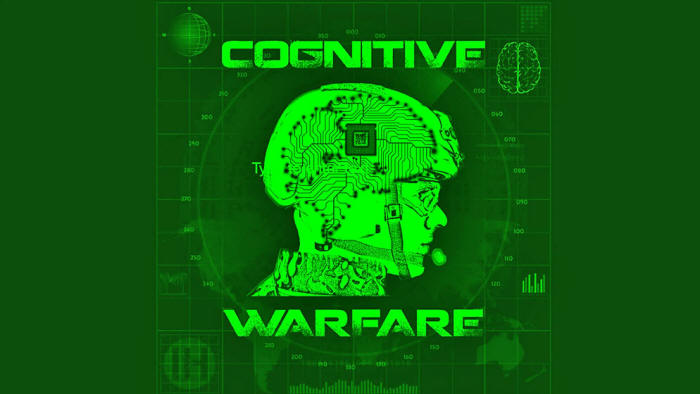
Source:
NATO Cognitive Warfare research paper
At an event hosted by the Modern War Institute at West Point in 2018, neuroscientist Dr. James Giordano told cadets that:
… the brain is and will be the 21st century battle scape in many ways, end of story…
You will encounter some form of neurocognitive science that has been weaponized not only in your military career but in your personal and professional lives…
The more I know about what makes you tick, the more my interactions can be geared with you to make you tick the way I want you to.”
As early as 1928, propaganda pioneer Edward Bernays understood how mind control could keep the public in line, proclaiming:
The conscious and intelligent manipulation of the organized habits and opinions of the masses is an important element in democratic society.
Those who manipulate this unseen mechanism of society constitute an invisible government which is the true ruling power of our country.
We are governed, our minds are molded, our tastes formed, our ideas suggested, largely by men we have never heard of.
In almost every act of our daily lives, whether in the sphere of politics or business, in our social conduct or our ethical thinking, we are dominated by the relatively small number of persons… who understand the mental processes and social patterns of the masses.
It is they who pull the wires which control the public mind.”
Bernays may not have envisioned this form of manipulation and control could be miniaturized and replicated for all in a handheld device.
There are ghosts in the machines we stare at while we work, inform, and entertain ourselves.
These ghosts are directing a covert war against us, deliberately spreading mis-and disinformation to confound, persuade, and control our thoughts and actions. The U.S. Army has made this plain.
We would do well to at least understand the nature of the offensive directed against us.
As the cognitive war rages against each of us, compelling us to accept this paradigm or get left behind, tough decisions must be made, and tough questions must be asked.
Will we buy into the scheme that equates humanity with mere machinery?
Or will we realize that we’ve been awesomely and wonderfully made by a divine Creator?
Will we participate in our own denigration, meekly complying with the selling of our data, invasion of our privacy, robbing of our wealth, and destruction of our freedom?
Or will we resist the militarization of our minds by defying the technocratic tyrants?
Will we say no to absolute transparency?
Or will we keep our heads in the sand as privacy ebbs away into the ocean of bio-digital surveillance?






